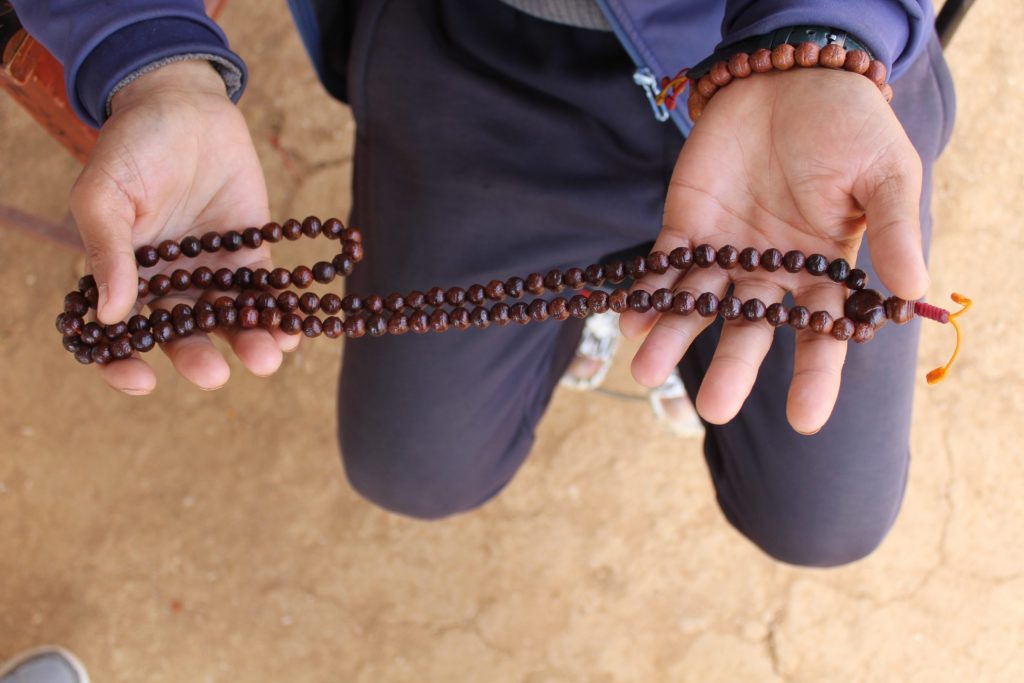Crying in spasms in front of a BBC News Nepali camera, Dil Bahadur Tamang says he can vividly see his beloved tree in his dreams. “What had this tree done anyway?” Tamang asks. “[They] could have negotiated a deal with us!” he adds. “As soon as I get out of my house, I see this mess.”
Last June, Dil Bahadur’s family’s Bodhichitta tree was sawed down to the ground at midnight by a group of masked intruders who arrived at his house with guns, homemade bombs, and a chain saw. The tree growing in Dil Bahadur’s backyard was believed by many to be one of the most valuable of its kind in Nepal—and one that had previously fetched its owner tens of millions of rupees in cash annually.
What makes trees like these so valuable are the seeds that grow inside the tree’s fruit. Out of all the Ziziphus species, Bodhichitta trees, or as locals call them, “Buddhachitta trees,” bear special types of seeds that take different appearances and sizes. The seeds are customarily strewn into a rosary (mala), often consisting of 108 similar beads, meant to be worn around the neck or as bracelets. These rosaries are dearly coveted by devotees of Buddhism, for their use in devotional rituals as well as to help practitioners keep count during their daily mantra recitations.
In 2015, a group of Nepali scientists described the Bodhichitta tree as a unique Ziziphus species, declaring the species endemic to Nepal, the country where the Buddha’s birthplace lies, and officially dubbed the plant Ziziphus budhensis. The timing coincided with an already flourishing Bodhichitta mala market in Nepal and ended up vigorously fueling the mala’s business even more, in the country and beyond.
According to popular myth, the seeds of the Bodhichitta plant were first left behind in the remote village of Timal in Nepal by legendary lotus-born Vajra master Padmasambhava, while he was there to meditate, sometime around the 8th century. Also known as “Guru Rinpoche,” Padmasambhava is revered as the “Second Buddha”—whose birth was foretold by the Shakyamuni Buddha—and is believed to have taken birth in the Swat Valley in present-day Pakistan. An Indian Buddhist master and central deity in the tantric Buddhist pantheon, Padmsambhava is credited with establishing Buddhism in Tibet and building the Samye Monastery, which was later destroyed during Chinese occupation in the late 1950s.
What was first left behind—or perhaps sowed—by the Vajra master at Timal as an auspicious symbol would go on to bring unprecedented wealth to the locals of the region and elsewhere in Nepal as the demand for the Bodhi mala grew throughout the world’s Buddhist countries. And yet, while initially thought to be a divine omen, the malas have now simultaneously robbed residents of sleep and security, an eerie atmosphere surrounding them as they guard their precious Bodhi trees as well as their own lives from theft, robbery, or even worse.
***
In Yangbel, a village of Timal, lies the Yarinag Guru Duphug Tongsum Kundag cave, where Padmasambhava is believed to have meditated during the 8th century. Round, pebble-like formations at the top of the cave are the remnants of the Guru’s mala, according to staff members. “We, too, don’t know how exactly these formations came to be,” they add. “That’s what everybody inquires about.”
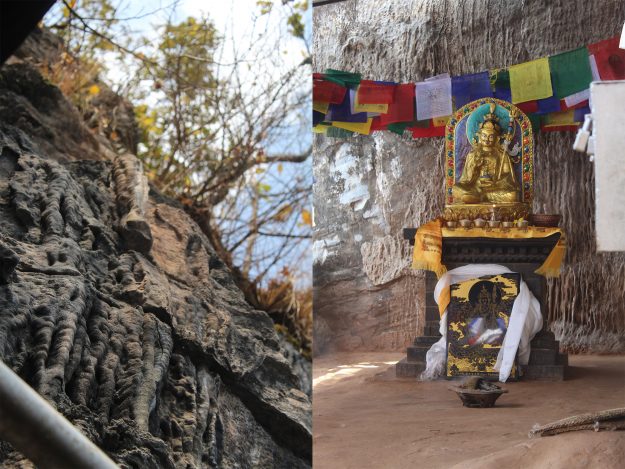
Nearby, at a cave called Duphug Tongsum, a Buddhist priest is assigned to look after the place and perform pujas. His name is Ngawang Dorjee Tamang, and he claims to be the descendant of a tulku—an accomplished Tibetan Buddhist spiritual master—who came to Nepal from Tibet during the reign of the fifth Dalai Lama. Together with a couple of other masters, they discovered the caves of Yangbel, and determined them to be one of the Vajra Guru’s meditation spots.
While initially thought to be a divine omen, the malas have now simultaneously robbed residents of sleep and security.
During his journey to Tibet, Padmasambhava stopped to meditate at a couple of caves in Nepal: Pharping, Halesi Mahadev, and here, at the caves of Yangbel. Ngawang explains, “In Nepal, [Padmasambhava] vanquished demons; spread the teachings of the Buddha; and left behind the ‘Ter’ mala [Ter: Tibetan word for treasure, and mala means rosary], here in the Yarinag cave.” The area had originally been called “Termala,” or “Termal,” but has since been modernized to “Timal.” “It is said that the Guru threw six seeds of the Buddhachitta plant into the air, letting them fall where they [might]. But all six of them fell here in Timal,” Ngawang explains.
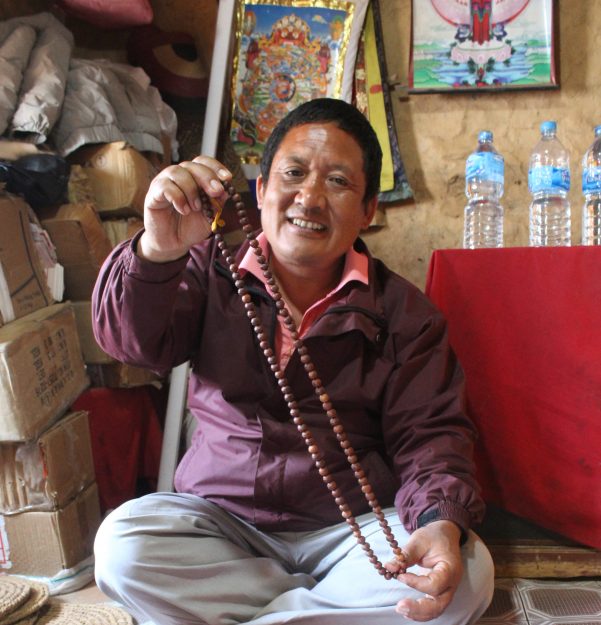
Although Ngawang has not yet come across any holy books that explicitly mention the Buddhachitta beads, he has read in a small book that somewhere, a tree sprouted out of the ground and branched into five branches—four on the outside and one in the middle. The outer four branches bore white, yellow, red, and green malas, respectively, and the one in the middle bore the Bodhichitta mala. “Those five malas are regarded as the five forms of the Pancha Buddha,” Ngawang adds.
***
Another local of Yangbel, a man named Santa Bahadur Lama, says, “I grew up under one of the Bodhi trees at my home; I played marbles with the beads. I [have been] acquainted with the plant ever since [I was] a child.”
Since trade had been intermittent during earlier years, with malas fetching Santa Bahadur’s family only a meager sum of 3,000 to 4,000 rupees a year, “Our fathers had a feeling that the thorny trees weren’t that rewarding after all.” As such, the family ended up cutting many of them down with the motive of cultivating vegetables in their backyard. Santa Bahadur estimates that if his family still had those trees today, they would be making millions of rupees a year. “Before 2011, when we were kids, the Bodhi mala did not hold much monetary value,” Santa Bahadur reminisces. “In mathematical terms, the beads’ market was not even around 10 percent of what it amounted to during its peak years [beginning in 2011],” he adds.
Santa Bahadur says his tribe was oblivious to the auspiciousness of the Bodhi beads before the mala business first erupted, but asserts that his village’s priests [lamas] had links with some Tibetans residing at Boudhanath, Swayambhu, and Thamel at Kathmandu. “The lamas traded the beads to the Tibetans for some amount higher than what they would pay to buy them in the village—that way, they were making some profits,” he adds.
There were no other mala dealers in the area except for those lamas, Santa Bahadur says, and they dealt in whatever quantity was available. “If the priests stopped collecting the beads, they would rot and go to waste.”
Santa Bahadur returned to his village around 2015, after hearing that the mala trade had skyrocketed. But he and his team couldn’t pivot quickly enough to reap the benefits of the now in-demand beads. Santa Bahadur attributes this to his team’s lack of access to proper links, an amicable environment to conduct business, and, quite rightly, the idea to go big-time. Gradually, the competition grew tougher, making it hard for them to keep up with the market, and eventually, his team quit.
With a heavy heart, Santa Bahadur left his village again and opened a multimedia shop in Banepa that he runs to this day. “But I haven’t completely given up on it; I still trade some beads annually,” Santa Bahadur says. “I get a meager quantity of beads shipped from the village and sell them to potential buyers who are led to my shop by my friends and tourist guides.”
While his dreams of Bodhichitta riches might be dashed for now, Santa Bahadur’s big brother, Guna Raj Syangbo, is currently an active mala dealer who owns a small rosary shop on the side of the steep stairs that lead to the Yarinag cave.
Asserting that he owns the land where he operates his business, Guna Raj cultivates Bodhichitta plants all over his steep and dry field. In fact, the entire area—including the whole of the staircase leading to the cave, the whole of the Yangbel village, as well as around a dozen of the neighboring villages—is covered almost entirely by Bodhichitta plants, barely leaving any barren space.
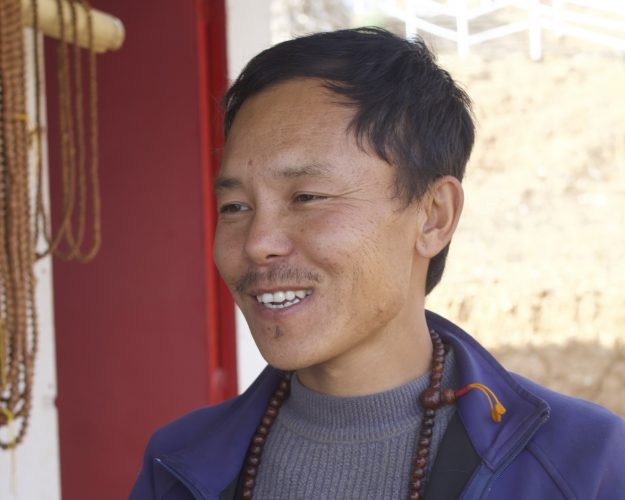
“You see, the land here is priceless nowadays,” Guna Raj says in an excited voice. “Local people are being offered to swap their land with land located in the capital Kathmandu, [and yet] nobody is willing to give up their lands here.”
Guna Raj asserts that Timal is the only place where one can find the original Bodhichitta beads, despite the plant now allegedly being cultivated throughout Nepal and in other countries. Therefore, religious tourists to the area take special interest in buying local mala. “People from Bhutan, Darjeeling, Sikkim, China, and even Sri Lanka come to see these caves! Just yesterday, there was a group of devotees from Myanmar,” Guna Raj says, furthermore claiming that when he meets Chinese and Bhutanese traders who come to Nepal during the mala season, they always praise the Nepali Bodhichitta beads as being of the highest quality. “They say that plants propagated in their countries bear plain seeds without much intricate details, and [thus, they are not as] special.”
During the mala season, dealers flock to the area in large numbers to buy all the quality beads, which are shipped either directly to China, or first to Kathmandu and then to China. The beads come in numerous faces, from one to nine, and in different sizes.
A mala must always have 108 similar beads and one distinctive guru bead that is often larger, more elaborate, or of a distinctive material or color. Two-eyed beads are the most common, with the one-eyed bead being slightly rarer. According to Guna Raj, for a bead to fetch a handsome price, it should be of three or more faces and should be larger in diameter. “Just last year, we sold beads with five faces for about 30,000 to 40,000 rupees for a single piece,” Guna Raj continues. He notes that the Chinese gold-plate these beads with wide, symmetrical eyes, turning what were formerly normal bracelets into very expensive items.
In 2015, Mitra Lal Pathak, a scientific officer at the Department of Plant Resource, Ministry of Forest and Environment, Nepal, was assigned to identify the species of the Bodhichitta plant brought to the laboratory by Timal locals. But after a thorough investigation, Dr. Pathak found that the species did not match with any other Ziziphus species recorded elsewhere in the world, and declared it a new species of the Ziziphus genus and as endemic to Nepal.
Only after the release of Pathak’s 2015 research paper did the Nepalese start showing interest in the plant. But earlier than that, around 2010–2011, many people, including Pathak, believed that the Fourteenth Dalai Lama praised the Bodhichitta mala as the most auspicious during one of his dharma talks. And since Nepal was the only country with a mala market, this purported endorsement brought a huge upsurge in mala business to Nepal.
It’s been more than a decade since locals of Timal started making fortunes by capitalizing on the plants that had forever been growing in their backyard. In the meantime, Pathak has conducted some informal experiments of his own on the plant. While he was in China pursuing his PhD, he compared samples of the plant with those of similar Chinese plants, and found that one species identically matched the Nepali plants at a molecular level. He also found out that the Chinese had already scientifically described the plant long before Nepali scientists did, in 1979, and had named it Ziziphus xianchengensis.
However, the plant has been sparsely distributed and lacks any notable population in China, with a thin population reported from alongside rivers in the Sichuan and Yunnan provinces. “Only now [have] people started taking saplings from Nepal and cultivating them there,” Pathak explains. He also planted some seeds of the plant around his home in Kawasoti—in the flatter Terai lands of Nepal—to disprove the idea that they thrive only in Nepal’s Timal region.
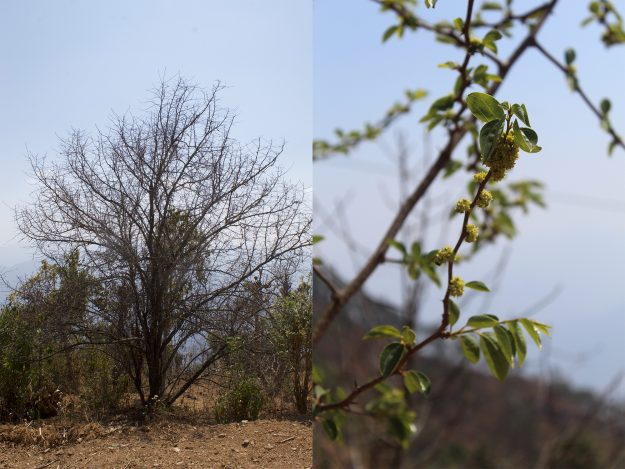
“After reaching a certain stage in life, people are now searching for peace of mind. . . . There’s nothing more important than that, and the Bodhichitta bead is [at the heart of this] quest for peace,” says Pathak.
***
At Shechen Monastery, situated just meters away from the Boudhanath stupa in Kathmandu, Kunkhyab, a lecturer explains that the name “Bodhichitta” has forever been used in Buddhism to denote a person’s wish for enlightenment.
Like Ngawang Dorjee at the Duphug Tongsum cave, Kunkhyab hasn’t come across any holy book with an explicit mention of the Bodhichitta beads. “Different mantras describe the mala in different ways, but I haven’t seen clear mention of the beads in words in any books whatsoever,” Kunkhyab stresses. He told me that while the Bodhi mala had gained popularity among monks in recent years, that many of his elders have attained wisdom without the need of a Bodhi mala.

However, Kunkhyab also expressed that the Bodhi mala is indeed special in the sense that the mala is compatible with every Buddhist mantra. When we spoke, he had a Bodhi mala with him. “It’s nine millimeters in size. For a lifetime of chanting, too small a size is not a good option,” Kunkhyab says. He explained that tiny beads tend to slip out of the fingers, hence mantra chanters do not use them much, and they are worn only for fashion. He adds, “If you are wearing a mala just for the sake of it, then it’s just an ornament. But for a practitioner, it will aid you in your sadhana (practice). With a Bodhi mala on, no pessimistic thoughts will ever arise in the mind.”
***
And yet, in a lesson that echoes Buddhist teachings on nonduality, what was initially a boon to the people of Timal and its neighboring regions has now unequivocally become a burden. “About one-third of the disputes in the judicial council of our rural municipality concern Bodhichitta,” Mim Bahadur Vaiba—vice president of the Roshi municipality, which neighbors Timal—told the BBC last June.
Narayan Humagai’s family, who live a few meters away from the Tamang family, said it has been difficult to recover a sense of security living in the area. “Dil Bahadur Taman was the one who planted this tree in my house,” Narayan says. “We are very scared about everything that happened.”
While the Deputy Superintendent of Police, Rajkumar Shrestha, spokesman for the Kavre district police department, said police would be deployed as needed, especially during the harvest season—which lasts from April through August—farmers still worry that even such measures will not help against those who come to their houses with saws and guns.
“After seeing [other] trees cut down in our area, we are afraid that the same thing will happen to us,” Narayan Humagai says. “People are jealous.”
Thank you for subscribing to Tricycle! As a nonprofit, we depend on readers like you to keep Buddhist teachings and practices widely available.
